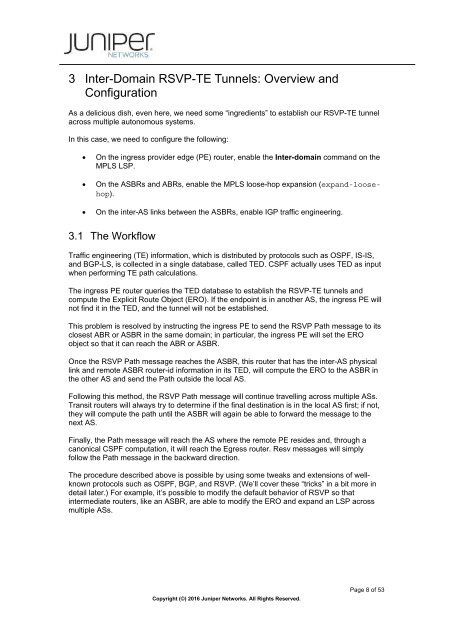2eW4ZRB
2eW4ZRB
2eW4ZRB
Create successful ePaper yourself
Turn your PDF publications into a flip-book with our unique Google optimized e-Paper software.
3 Inter-Domain RSVP-TE Tunnels: Overview and<br />
Configuration<br />
As a delicious dish, even here, we need some “ingredients” to establish our RSVP-TE tunnel<br />
across multiple autonomous systems.<br />
In this case, we need to configure the following:<br />
• On the ingress provider edge (PE) router, enable the Inter-domain command on the<br />
MPLS LSP.<br />
• On the ASBRs and ABRs, enable the MPLS loose-hop expansion (expand-loosehop).<br />
• On the inter-AS links between the ASBRs, enable IGP traffic engineering.<br />
3.1 The Workflow<br />
Traffic engineering (TE) information, which is distributed by protocols such as OSPF, IS-IS,<br />
and BGP-LS, is collected in a single database, called TED. CSPF actually uses TED as input<br />
when performing TE path calculations.<br />
The ingress PE router queries the TED database to establish the RSVP-TE tunnels and<br />
compute the Explicit Route Object (ERO). If the endpoint is in another AS, the ingress PE will<br />
not find it in the TED, and the tunnel will not be established.<br />
This problem is resolved by instructing the ingress PE to send the RSVP Path message to its<br />
closest ABR or ASBR in the same domain; in particular, the ingress PE will set the ERO<br />
object so that it can reach the ABR or ASBR.<br />
Once the RSVP Path message reaches the ASBR, this router that has the inter-AS physical<br />
link and remote ASBR router-id information in its TED, will compute the ERO to the ASBR in<br />
the other AS and send the Path outside the local AS.<br />
Following this method, the RSVP Path message will continue travelling across multiple ASs.<br />
Transit routers will always try to determine if the final destination is in the local AS first; if not,<br />
they will compute the path until the ASBR will again be able to forward the message to the<br />
next AS.<br />
Finally, the Path message will reach the AS where the remote PE resides and, through a<br />
canonical CSPF computation, it will reach the Egress router. Resv messages will simply<br />
follow the Path message in the backward direction.<br />
The procedure described above is possible by using some tweaks and extensions of wellknown<br />
protocols such as OSPF, BGP, and RSVP. (We’ll cover these “tricks” in a bit more in<br />
detail later.) For example, it’s possible to modify the default behavior of RSVP so that<br />
intermediate routers, like an ASBR, are able to modify the ERO and expand an LSP across<br />
multiple ASs.<br />
Copyright (©) 2016 Juniper Networks. All Rights Reserved.<br />
Page 8 of 53


